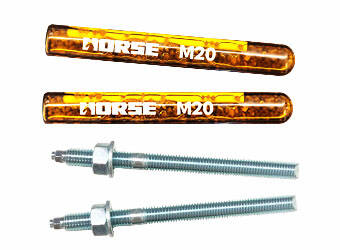Solutions
Horse Construction offers full range of structural strengthening materials with technical supports, documentation supports, products supports, project supports.
The Difference Between Anchoring Adhesive And Anchor Bolts


The anchoring principles of the two are slightly different:
(1) The planting bar can be matched with screws of different specifications; while chemical anchor bolts can only be matched with screws of different specifications.
(2) Reinforcing bars are not applicable to plain concrete components, including the post-anchor design of components with longitudinally stressed steel bars with a reinforcement ratio of less than 0.2% on one side. Since the reinforcement technology is mainly used to connect the original structural components and the newly-added components, this connection is effective and reliable only when the original component concrete has a normal reinforcement ratio and sufficient stirrups. The planting bars of plain concrete components and low-reinforcement components should be designed according to anchor bolts. Chemical anchors are suitable for ordinary concrete load-bearing structures, but not for lightweight concrete structures and severely weathered structures. The anchor bolts of lightweight concrete structures should be anchored with special anchor bolts adapted to their material properties. At present, domestic and foreign products of different brands and functions are available on the market. It is obvious that the severely weathered concrete structure cannot be used as the base material for anchor bolts. However, if anchor bolts must be used, the anchored components should be replaced with concrete first, and then anchor bolts can be implanted to play a bearing role.
(3) The damage form of the planted bar is easy to control, and generally the damage of the anchor bar steel can be controlled. Therefore, it is suitable for the anchoring connection of structural members and non-structural members with static seismic fortification intensity ≦ 8 degrees. Chemical anchors are generally thick and short, with shallow anchor depths, poor adaptability to substrate cracks, and low bearing capacity. They are not suitable for the post-anchor connection of structures under tension and edge shear and structural components of lifeline engineering.
The specific differences are reflected in:
1. The force principle is different: the planting bar must be a full screw or ribbed steel bar, and the adhesive force is used to achieve the force; the anchor bolt is allowed to have a smooth screw and the mechanical lock key force is used for force.
2. The selection basis of force value is different: the planting bar is to give full play to the full performance of steel; the anchor bolt force value is certified according to the "Unified Standard for Reliability Design of Concrete Structures" GB50068 while referring to the European ETAG anchor bolt standard using probability theory.
3. The anchoring depth is different: the anchoring depth of the anchor bolt should be less than 10d, and the anchoring depth of the planting bar is generally greater than 15d after using the calculation formula.
4. Different types of failure: Normally, there is only one type of failure for planting steel bars, and the allowable failure modes for anchor bolts are: anchor bolt steel damage and concrete cone damage.
5. Spacing and marginal distances are different: there is no requirement for planting bars in the new "Code for Design of Reinforcement of Concrete Structures". It is just a rule on the structure, and the anchor bolt not only has the minimum spacing and minimum margin requirements, but also considers the role of the group anchor.
After talking about so many differences, what is the most worthy of concern or what should they pay attention to in actual application?
The concrete strength grade of the original component directly affects the bonding performance between the planted bar and the concrete, especially the cantilever structure and components are more sensitive. For this reason, it is necessary to stipulate the minimum requirements for the concrete strength grade of the original component of the planting bar:
a) When the newly added component is a cantilever structural component, the concrete strength grade of the original component shall not be lower than C25;
b) When the newly added component is another structural component, the concrete strength grade of the original component shall not be lower than C20.
Anchor components: first strengthen and then plant the bars. The concrete at the place where the load-bearing members are planted should be solid, free of local defects, and equipped with appropriate amounts of steel bars and stirrups, so that the planting bars can be stressed normally. Therefore, no part is allowed to exist in the anchoring position; even if it is outside the anchoring position, it should be reinforced before planting the bar to ensure safety and quality.
Reinforcing bar glue: In order to ensure the safety of the application of bar planting technology in load-bearing structures, the adhesive used for planting bars should be modified epoxy structural adhesive or modified vinyl ester structural adhesive. When the diameter of the implanted bar is greater than 22mrn, Grade A glue should be used.
Component damage: The anchorage of the planting bar of the load-bearing component should be calculated and structured to prevent concrete damage and pull-out damage.
You can find anything here you are in need of, have a trust trying on these products, you will find the big difference after that.

two-components modified epoxy resin adhesive, with high quality plastic tube, double cartridge package

High-strength anchor bolt with vinyl resin as main materials, composed of selected quartz sands, curing agents and glass tubes

Two-components modified epoxy resin adhesive, with high quality plastic tube, double cartridge package for anchoring